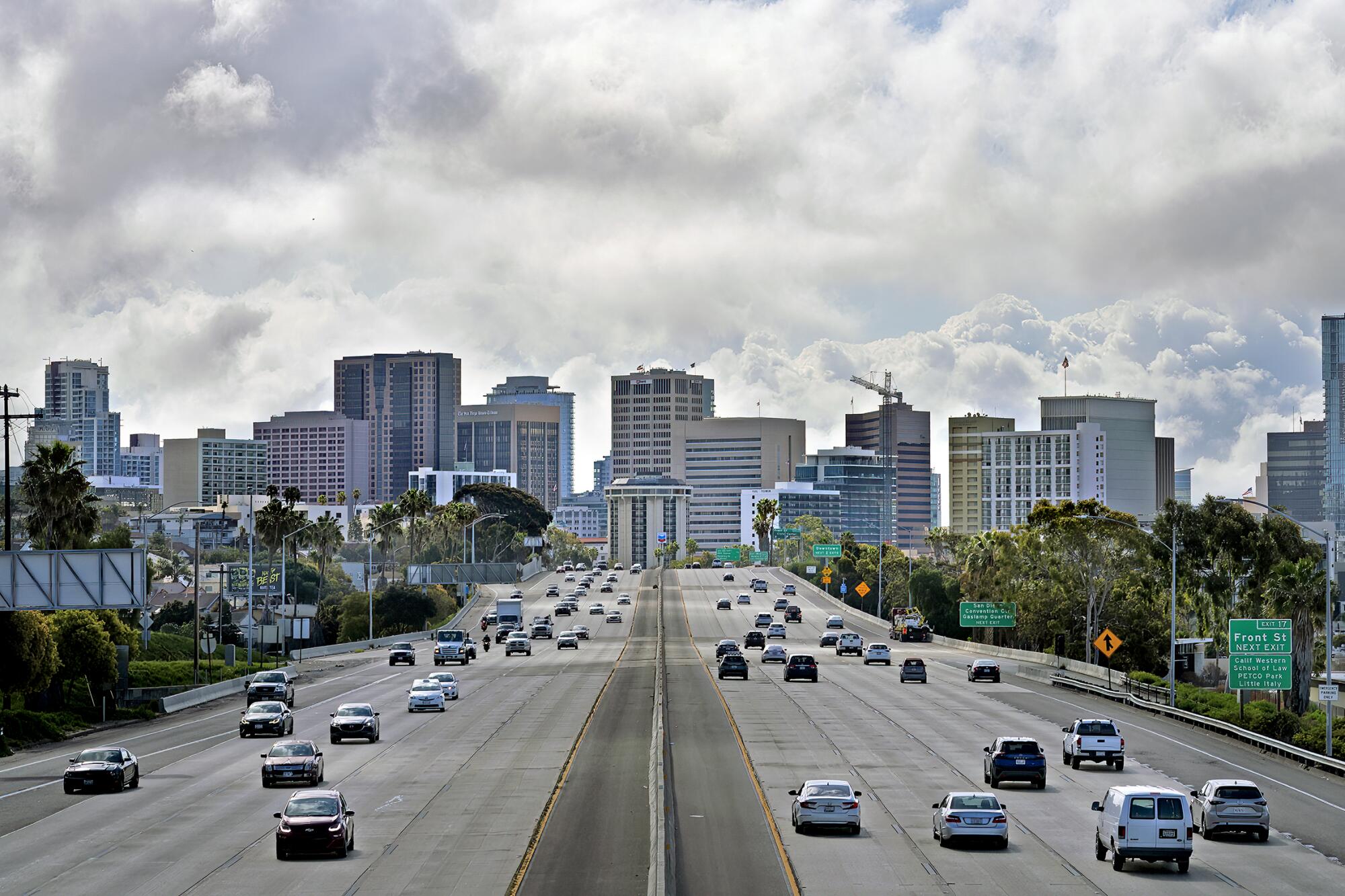
New Census Bureau data reveal that a combination of births and immigrants moving into the county over the last year wasn’t enough to make up for the unexpectedly high exodus of residents who left the county between 2022 and 2023.
Against the backdrop of soaring housing costs in the last year, tens of thousands of San Diego County residents decided to take a big leap. They left.
New estimates released Thursday by the U.S. Census Bureau reveal that close to 31,000 more people moved out of the county than moved in between July of 2022 and July of 2023 — almost double what it was a year earlier. With the exception of the first year of the pandemic, when the net outflow exceeded 33,000, that volume of people exiting the county hasn’t been seen in nearly three decades.
This story is for subscribers
We offer subscribers exclusive access to our best journalism.
Thank you for your support.
The net effect was a slight dip in San Diego County’s overall population last year— just a year after the region had returned to population growth following a COVID-19-fueled decline. As of July, the county’s population was estimated to be 3.27 million, down by nearly 7,100 from 2022.
Were it not for the unexpectedly huge outflow of locals, San Diego might have had a shot at a modest increase in population. The county’s natural growth — the number of births outpacing deaths — approached 13,000 between 2022 and 2023. And, in a departure from years past, international migration jumped to nearly 10,800. But together, those two growth components weren’t enough to overcome the wave of people leaving the county.
The last time San Diego County saw a comparable exodus of residents was in the early 1990s, when the region was mired in a deep recession and the jobless rate had surged to nearly 8 percent.
While there are many factors driving people to move from the county to elsewhere in California or out of state, demographers agree that the leading motivator is the region’s unabated rise in the cost of housing, coupled with a still lingering willingness of many employers to permit remote work.
Even so, the 2023 estimates came as a surprise given that just a year ago, Census data suggested that San Diego was poised for a turnaround from the declines wrought by a once-in-a-century pandemic.
“That big jump to more than 30,000 leaving — that shouldn’t be happening. You’re recovering from COVID, the economy is growing, yet you’re losing people more rapidly at the same time that the number of immigrants has started to jump up,” said Dowell Myers, a professor of policy, planning and demography at USC. “I’d say this is due to skyrocketing housing prices. Remote work was possible before COVID, but now we know it’s even more viable to do that, and it’s a great solution to high housing prices.
“Keep your job in San Diego and move to Las Vegas or some other county that’s more affordable.”
The exodus, which has grown exponentially over the past several years, is a pattern that’s been repeating itself across most California counties for some time, even in inland areas that were once a refuge for residents priced out of coastal California. Among the top 10 counties in the country with the highest level of net out-migration, four are in California — Los Angeles, Orange, San Diego and Santa Clara.
The Census Bureau noted, though, that migration is beginning to slow among those areas with the largest flows of people in and out of their counties. But not in San Diego.
It was among a handful of counties — Orange, Miami-Dade and Dallas — that bucked the trend and instead showed an uptick in people moving out compared to a year earlier.
“Areas that had been experiencing higher levels of domestic migration, they are now slightly decreasing ,” said Census Bureau demographer Kristie Wilder. “There was a lot of movement during the height of the pandemic, and 2022 was the first full year we could see the results of the lifted travel restrictions, so we are seeing a slowdown in domestic migration where things are moving toward pre-pandemic levels.”
Up and down California, there were few counties last year that did not experience a net loss of people who moved to other destinations. Just 10 of 58 counties in the state saw more people arrive than leave, led by Riverside, with a net inflow of 7,807 new residents. That’s a pittance, though, compared to the 50,000 to 60,000 people who flooded into the county during the housing bubble of the early 2000s.
“This is consistent with the stuff we’ve found in California as a whole — that the places with high housing values are the same places where people are leaving,” said Eric McGhee, a senior fellow at the Public Policy Institute of California. “We’ve tracked California’s net out-migration over time against the relative cost of housing in other states, and the two line up pretty well. And the cost of housing has really accelerated in California in the last 10 years.”
Whether it’s for-sale or rental housing, San Diego County has seen a meteoric rise in costs over the past few years, forcing both recent arrivals and long-term residents to reconsider whether San Diego should remain their permanent home. Ranked as the eighth most expensive rental market in the country, San Diego County had an average monthly rent in early March of $2,414, according to real estate tracker CoStar. That’s up 24 percent since the same time in 2020.
Meanwhile, the median price of a home — which includes single-family dwellings, condos and townhouses — rose to $802,500 in January, surging 37 percent since the same time in 2020, reported data firm CoreLogic. Mortgage rates, which were at historic lows just three years ago, have more than doubled, making homeownership more out of reach than ever.
“The people who are leaving are likely the lower-income to middle-income categories,” said Alan Gin, an economist at the University of San Diego. “They want to leave because they can’t afford housing.”
He said the recent population loss was not big enough yet to make a dent in the economy, but if it remains a long-term trend it could spell trouble. Fewer residents means fewer customers in restaurants, bars and other businesses, Gin said. Another issue is companies having difficulty finding workers, which he said is already a challenge facing several industries.
While some remote workers have the flexibility to keep their jobs here while living outside the county, that ends up being an economic hit to San Diego, says Gin. It means those once San Diego-based workers are no longer spending money in the community where they live, nor are they helping sustain local businesses, and as a result, are contributing to a decrease in state and local tax revenue.
Longtime San Diego demographer John Weeks suspects that some of last year’s moves out of the county may include recent arrivals from foreign countries who have grown disenchanted with San Diego.
“We don’t know all the facts here, but some of the domestic out-migration is bound to be international migrants who came and then decided to leave,” said Weeks, director of the International Population Center at San Diego State University. “They could have come from Mexico or China the previous year, and maybe they didn’t find the jobs or housing they wanted, so they leave. It’s not just long-term residents of San Diego County who are leaving.”
Yet many former county residents who responded to a query from the Union-Tribune said they had lived here for decades before finally opting to relocate. Their reasons were many — traffic, rising homelessness, failing infrastructure, shifting local and state politics, and a lack of affordable housing. They moved to Oregon, Colorado, New Mexico, and North and South Carolina, among other states.

Brooke Moore, 44, a lifelong San Diegan, said she and her husband Matthew could no longer take the stress of rising rents, multiple moves within the county, and failed efforts to buy a home. So they finally sat down and compiled a list of states where they’d be willing to relocate, and in January of last year moved out of their rented home in Santee with three of their children to a small Illinois town two hours outside of Chicago.
“It was hugely hard,” said Moore, thinking back on the decision to uproot their family and move to another state. “My husband has never left the state. But I was carrying all this baggage and the stress of money. It just felt like our life was going to implode. I thought, one more bill and I didn’t know what I was going to do.
“My husband was making $25 an hour in construction, and I finally was making $100,000 a year, and we still felt broke.”
And so they traded in their $3,400-a-month rental for a five-bedroom, three-bath home on a nearly quarter-acre lot in Rock Island, Ill., that they purchased for $210,000. Their monthly mortgage payment is $1,700. Moore was able to keep her pharmaceutical job — she’s now working remotely — and her husband left construction to work as a warehouse operator for John Deere tractors.
“Ten years ago, I never would have thought to leave,” she said. “But the San Diego I fell in love with is different now — more people, more traffic, and just things we would go to now feel overcrowded. I do miss my family and my friends and parents, but I’m at peace.”
Even with a population that is declining or simply not growing, San Diego County can feel more crowded than ever, especially for people who live in denser, more urbanized areas, says Ray Major, chief economist for the San Diego Association of Governments.
Major said efforts to densify the region are a huge factor in why it seems like some neighborhoods are overrun by cars, pedestrians and bicyclists. He pointed out that today’s planners are increasingly focused on fitting people into city neighborhoods, whereas, in the last century, the focus tended to favor suburban development in the eastern, northern and southern reaches of the county.
For example, it’s much more likely these days for a developer to seek approval for a large apartment complex in a neighborhood like Hillcrest than propose tract homes in unincorporated San Diego County.
“There is a densification of urban areas to create walkable, livable areas where you can live/work/recreate in the same place,” Major said. “(In the 1990s) we would have been building subdivisions all the way to Temecula.”
The latest Census numbers align with SANDAG’s population forecast last year that predicted San Diego County’s population would peak at 3.4 million in about 20 years and then drop off. That was down from previous forecasts that had the population hitting 4 million. Major said the association came to the conclusion population would drop because of housing and rent prices and, in general, the higher cost of living in San Diego compared to much of the nation.
Demographer Weeks agrees, saying the county is consigned to a future of little or no growth.
“By and large, we’re at a point where one year we lose a few people and then gain them back the next year, so we’re basically at a point where the population now is where it’s going to be,” Weeks said. “We’re now way past the stage of trying to figure out how to accommodate more people each year.”
Get U-T Business in your inbox on Mondays
Get ready for your week with the week’s top business stories from San Diego and California, in your inbox Monday mornings.
You may occasionally receive promotional content from the San Diego Union-Tribune.

